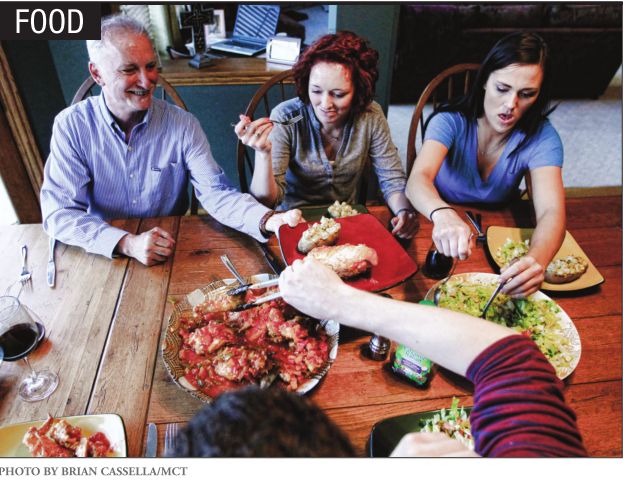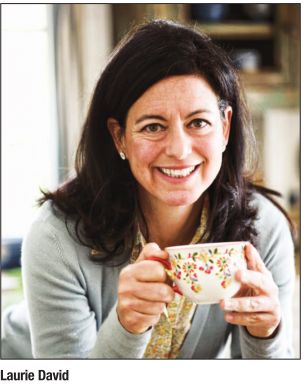
FOOD | Julianne Glatz
“I would put the emphasis on just looking at where your family is now and seeing what you can do to improve.”
That remark by Dr. Dianne Neumark-Sztainer, a University of Minnesota professor who has conducted groundbreaking studies about healthy eating and the positive effects of family meals, is a clear message that moving towards routinely eating meals with your family isn’t an all-or-nothing proposition: it’s a process rather than an event. But if you and your family don’t have a tradition of regular family meals, it may be hard to know where to start.
For me and my family, that wasn’t the case.
When I was growing up, it was a rare exception if my mom and dad and I, and usually my maternal grandparents, didn’t eat dinner together. It’s something I took entirely for granted, something I continued after I married and had children of my own.
But for anyone who’d like to begin incorporating more family meals into their routine – times when everyone sits down together to share not only food, but conversation and interaction – The Family Dinner, Great Ways to Connect with Your Kids One Meal at a Time, a book by Laurie David with recipes by Kirstin Uhrenholdt, is an invaluable resource. It’s even useful and enjoyable for families that already regularly eat together, filled with creative and fun ideas that can make family meals even more meaningful.
David talks about the whys of family meals in the book’s opening pages: the facts and figures that reveal the extraordinarily beneficial effects of regular family meals. But most of The Family Dinner is devoted to hows that range from the practical to the profound. There are chapters about “Simple Steps to Family Dinners,” “Fast Recipes That can Save Weekday Dinners,” and “Take It Slow: Cook Today, Eat Tomorrow – or Freeze for Another Day.” There are chapters that focus on getting children involved in helping cook family dinners (with suggestions about what tasks are appropriate for young children) as well as “Setting the Scene,” a.k.a. setting and decorating the table. Uhrenholdt’s recipes use real food, eschewing highly processed ingredients, and are kid-friendly without being dumbed down.
On the profound side, “Table Talk” has word games for younger children; for older children and teenagers there are tips about conversation-starters. “Read Around the Table” encourages family dinners to include everything from poetry to discussions of current events and moral dilemmas such as “Do you give money to homeless people if there’s a chance they might buy
alcohol with it?” or “If you accept an invitation and a better offer
comes along, is it OK to cancel the first one?” David also writes about
grandparents and extended family, and includes a chapter on “Grace is
Gratitude, Ways to Say Thank You and Appreciate Life’s Gifts.” She even
tackles the difficult and delicate subject of maintaining family dinners
after divorce with a frank discussion of how she, her ex-husband, and
their two teenaged daughters handled the experience.
David is best known as an environmental activist and producer (She produced former Vice President Al Gore’s documentary An Inconvenient Truth.)
She’s clearly well-connected. Numerous quotes, interviews and other sidebars throughout The Family Dinner are from celebrities, from renowned chefs to Tom Hanks and even Judge Judy.
But Laurie David wants the same thing for her family as do lots of other less well-connected folks. At the end of The Family Dinner she
writes, “When I first discovered the importance of family dinner, I was
desperate for some fulfilling family moments. When I started looking at
dinnertime as a gift in the day, I was rewarded with my most joyful
parenting moments. My best family times are not on weekends, vacations
or even holidays. They are around the kitchen table, just sitting
together meal after meal after meal…. Dinner is home.”
Arroz con Pollo The name may sound exotic, but Arroz con
Pollo
is simply chicken and rice – albeit chicken and rice with Latin
American flavors. David and Uhrenholdt say, “It is the warm embrace of a
Cuban mom, all in one big pot.” They suggest serving it with a plate of
avocado wedges, ripe tomatoes and slivers of red onions, sprinkled with
salt and fresh lime juice.
• 2 T. olive oil
• 6 boneless organic chicken thighs, skinned if desired, cut in half
• 4 organic chicken drumsticks, skinned if desired
• Salt and pepper to taste
• 2 medium onions, chopped (about 2 c.)
• 1 red bell pepper, seeded and chopped
• 2 tsp. ground cumin
• 3 cloves garlic, chopped
• 1 tsp. dried oregano, or 1 T. chopped fresh oregano
• 1 15 oz. can chopped tomatoes, undrained
• 3 c. chicken broth or stock, low sodium if purchased, plus additional if needed
• 1 c. white wine, or substitute an additional cup of chicken stock
• 1 tsp. paprika
• 1/2 tsp. turmeric
• 2 c. white rice (NOT instant)
• 1 c. freshly shucked or defrosted frozen peas.
For the garnish:
• Chopped cilantro
• Toasted pumpkin seeds (pepitas)
• Sour cream or Greek yogurt
• Green pimento-stuffed olives
In a large casserole,
heat the oil over medium high heat until it’s hot but not smoking. Pat
the chicken pieces dry with a lint-free towel or paper towels. Sprinkle
the chicken pieces with a bit of salt and brown them, about 2 minutes
per side. Transfer the chicken to a bowl and pour out all but 2 T. of
the fat.
To the
casserole, add the onions and bell pepper and cook over medium heat,
stirring, until the vegetables are softened, about 5 or 6 minutes.
Add
the cumin, garlic and oregano and stir for a moment until fragrant. Now
add the chopped tomatoes and return the chicken to the casserole. Stir
well to coat the chicken with the tomato mixture.
Add
the broth, wine or additional broth, spices and rice, stirring gently
to combine. Bring to a boil, reduce the heat to a bare simmer, and let
cook for about 20 minutes, until the rice and chicken are cooked
through. If the tomato-chicken mixture starts to dry out, and the rice
is still not quite done, add a bit more broth. If it is too soupy,
uncover during the last 5 minutes of cooking.
Just before it is done, stir in the peas.
Season
to taste with salt and pepper. Sprinkle with the chopped cilantro and
serve, passing the pumpkin seeds, sour cream, and olives for diners to
add as they wish. Serves 6.
Adapted from a recipe in The Family Dinner.
A frozen yogurt parlor at your table (No ice cream maker needed)
For the frozen yogurt:
• 1 lb. frozen good-quality fruit (NOT unthawed)
• 1/2 c. honey [or more or less to taste, depending on the fruits’ sweetness]
• 1 c. plain Greek yogurt
• 1 tsp. fresh lemon juice
• 1 tsp. vanilla • pinch of salt
For the toppings:
• Chopped fresh fruit like strawberries, mangoes, and bananas
• Crunchy cereal
• Chocolate chips
• Chopped nuts
Combine the frozen fruit
and honey in a food processor. Pulse quickly until coarsely chopped. Add
the yogurt, lemon juice, vanilla and salt. Process until smooth and
creamy, scraping down the sides of the bowl once or twice.
The
frozen yogurt should be firm enough to be served directly from the food
processor, but if it is a little soft, let it harden in the freezer for
about 30 minutes. Serves 4-6.
Leftover
tip: Frozen yogurt is a great way to use up uneaten cut up fruit, the
berries in the fridge that are just hanging in there, and the fruit you
bought too much of.
Spread
the fruit out on baking sheets so the pieces of fruit freeze
individually. Put them in containers so they are ready for the next time
you need them.
Adapted from a recipe in The Family Dinner.
Contact Julianne Glatz at [email protected].